|
Secret Handover of
New Landing Craft.
Handover from the Manufacturer to the Royal Navy
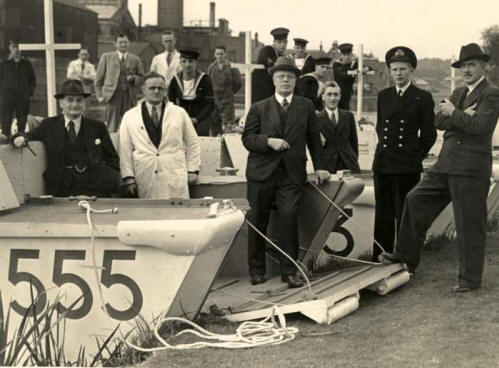
Background
These rare photographs
are from Mike Taylor, whose father, Cyril Taylor, worked for the manufacturer
from 1925 (age 16) to his retirement in 1974. The photos show newly completed Landing Craft Assault (LCAs) being handed over to
the Royal Navy by builders, Elliotts of Reading, Berkshire, England. It is
believed the photographs were taken in September 1944.
[Photo; Mike Taylor
was involved in testing the craft on the river prior to handover and
he can be seen standing between and behind a naval officer and Mr. Elliott,
one of the directors of the firm. The person in the white
coat was Reg Hemmings who later became a director. It is believed the
other civilians in the photos were also in the employ of Elliotts
having played their part in the construction of the craft].
LCAs were
produced throughout the period 1940-1944 and carried pennant numbers in the series 1 to 2030
for the purpose of identification. The craft in the photos were numbered LCA 1551 to LCA
1556 inclusively and were, therefore, amongst the last 500 produced.
 Role of
LCAs Role of
LCAs
LCAs had their
own engines but lacked the range and physical characteristics to undertake
long sea voyages under their own power.
They were, therefore, transported on Landing Ship Infantry (LSIs), also
referred to as 'mother ships'.
[Photo;
The 6 landing craft assembled prior to
handover ceremony].
On
arrival at their destination, a few miles off the landing beach, the LCAs
were lowered from davits into the water, laden with 35 fully armed troops.
From there, they usually assembled into formation and proceeded under their own power to
predetermined positions on the landing beaches.
Each
flat bottomed LCA measured close to 14 metres in length by 3 metres
across the
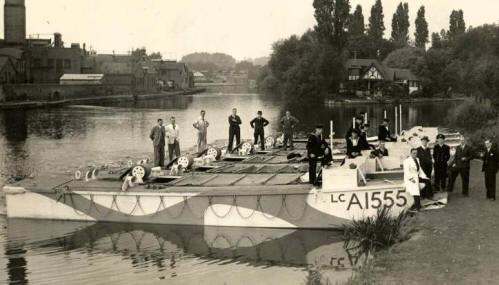 bows and could carry 35 assault troops and
800 pounds of equipment together with the craft's 4 man Combined Operations
(Royal Navy) crew. The Coxswain manned
his station starboard (right) side forward and to his left, in position
portside forward, was the bow gunner. bows and could carry 35 assault troops and
800 pounds of equipment together with the craft's 4 man Combined Operations
(Royal Navy) crew. The Coxswain manned
his station starboard (right) side forward and to his left, in position
portside forward, was the bow gunner.
[Photo;
Repositioned for ease of access in
readiness for the handover ceremony].
The troop space within each craft was
6 metres by 3 metres with a Bren gun on the portside (left) and two .303 Lewis Machine Guns. Some craft
are recorded as having mortars fitted aft. The LCAs were powered by two
65hp Ford V-8 engines and could achieve 6 knots when fully loaded.
In an assault operation, a boat officer
commanded 3 LCAs and was carried aboard one of the craft. That craft relayed
signals and orders to the other two craft in the group.
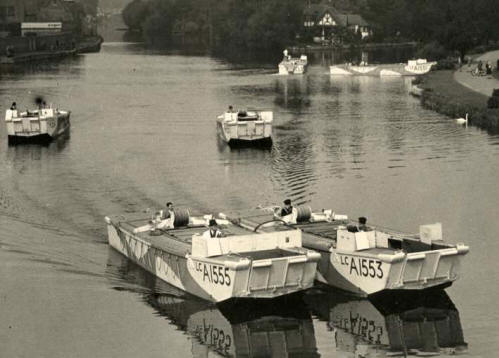 Elliott's premises stretched down to the
River Thames and the handover took place just above Reading Bridge. Elliott's premises stretched down to the
River Thames and the handover took place just above Reading Bridge.
[Photo;
After the ceremony the craft were taken down the river by naval personnel and
Elliott's staff. Family folklore suggests that Cyril Taylor was
amongst those delivering the craft to London].
Only one LCA was lost within the 1500 number
sequence. On August 17th, 1945, LCA 1591 was lost overboard from
a Landing Ship Tank (LST) off India, which raises the possibility that the
craft shown here may also have seen service in the Far East. At the time of
the handover in September 1944, 3 months after the Normandy landings, the need
for LCAs in the west had diminished, although both
Walcheren (Operation Infatuate) and the Rhine crossing were later.
Further Reading
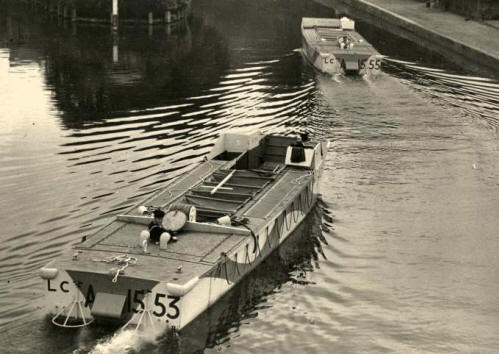 On this
website there are around 50 accounts of
landing craft training and
operations and landing craft
training establishments. On this
website there are around 50 accounts of
landing craft training and
operations and landing craft
training establishments.
Appeal for Information
Any former employees of
Elliott's Yard, their families, or Royal Navy personnel, who have
recollections or photos from this period are invited to
contact us. Even the smallest piece of information could
be of interest.
[Photo; The craft just below Reading Bridge
heading off towards London].
Correspondence
My dad, Darrell Collier (Jack), worked in the drawing office at Elliotts
of Reading during the war. He remembered the handover of the landing
craft and a trip up the Thames with the Mayor of Reading and his family on
board. As my dad was not part of the official handover team, he sat in
the engine compartment out of sight. After the war we came to know the Mayor's
daughter who also remembered the trip.
Kind regards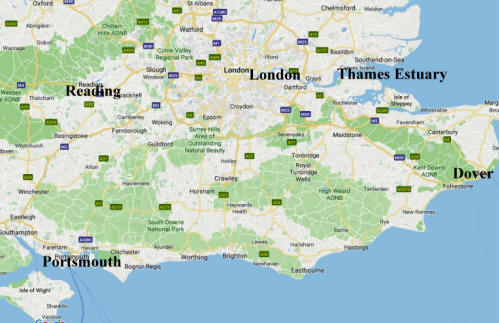
Derek Collier
[Map courtesy of Google 2019].
When I left school in
1955, I worked in the garage just inside the main gates of Elliotts. The workshop
(or garage) backed on to Thorneycrofts yard and we had a door that went into
same. My boss in the garage was Ron Wise and he told me many stories about
the goings on in there. One of them was about a boat they made with a
turbine engine for patrol use or whatever. It was too fast for the river so
they tested it in the dreadnought reach below Caversham lock. Evidently it
was the first turbine powered boat at the time. Bob.
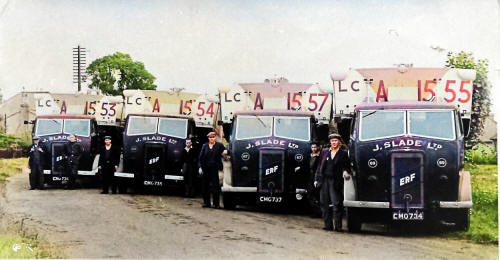 The
landing craft opposite are from the same batch seen on the Thames in the
main article above. This raises the possibility that the amphibious event
was a ceremonial handover prior to transportation by road to their
destinations. The
landing craft opposite are from the same batch seen on the Thames in the
main article above. This raises the possibility that the amphibious event
was a ceremonial handover prior to transportation by road to their
destinations.
[Photo courtesy of
Alec Brown; 4 LCAs loaded up for transport to their new owners].
Alec Brown writes; "My granddad, Ernest Brown (far
right) and my Uncle Les Brown (2nd right) delivering LCAs from Elliotts."
This amazing photo provides an insight into the scale of production and
delivery methods of the ubiquitous Landing Craft Assault.
|








